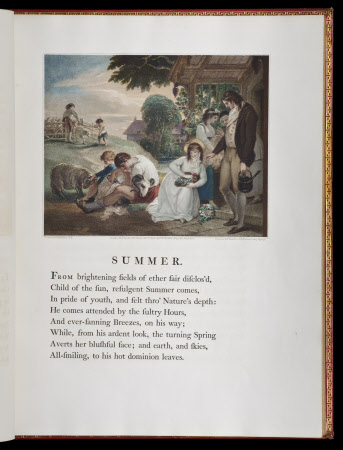The seasons, / by James Thomson. Illustrated with engravings by F. Bartolozzi, R.A. and P. W. Tomkins, ... from original pictures painted for the work by W. Hamilton, R.A.
James Thomson (1700-1748)
Category
Books
Date
1798
Materials
Book with binding of red straight-grained morocco over thick boards, gilt fillets and tool Greek-style border; with paper loosely placed in book.
Place of origin
London
Order this imageCollection
Anglesey Abbey, Cambridgeshire
NT 3026043
Summary
James Thomson, The Seasons, London: printed for P.W. Tomkins, 1797 [i.e. 1798]. Binding: Eighteenth-century full red straight-grained morocco over thick boards; gilt fillets and tools to form an elaborate, Greek-style border; spine, edges and inner borders gilt; dark blue spine label with title ‘Thomson’s Seasons’; sewn on six raised bands; paper edges gilt; binder’s ticket of L. Staggemeier, London.
Full description
Thomson’s ‘The Seasons’, originally published between 1726 and 1730, and extensively revised between 1743 and 1746, was one of the most frequently printed eighteenth-century poems. A blank-verse description, in four books, of the natural world and man’s place in it, it had appeared in over 400 editions by the 1870s. it was the model for the most topographical verse in the second half of the century; as well as the source for Haydn’s last oratorio ‘Die Jahreszeiten’, and was admired (with reservations) by Wordsworth and Coleridge. The first complete edition was illustrated with engravings after William Kent; the poem also provided inspiration for a wide variety of artists, including Gainsborough, Fuseli and Turner. This fine edition dates from 50 years after the poem appeared in its final form, and combines the talents of some of the foremost book artists of the period. The edition includes 20 illustrations, including five full-page plates, by William Hamilton (1751-1801). Hamilton trained in Italy in his youth, and was afterwards employed by Robert Adam as a decorative painter at Kedleston Hall, Derbyshire, and Highcliffe. He later became established as a painter of historical subjects and portraits. In the latter capacity his sitters included Sarah Siddons and other figures from the stage, and his work as a whole has a noticeably theatrical quality. Hamilton’s designs for ‘The Seasons’ were executed in oils, and engraved by Peltro William Tomkins (1759-1840) and Francesco Bartolozzi (1728-1815). Born in Florence, Bartolozzi had worked for Piranesi before being lured to Britain by the promise of the position of engraver to the king. He soon become one of the most successful engravers in Britain and maintained a large workshop. Tomkins was a former pupil who had produced stipple engravings for a wide variety of publishers before setting up in business with his brother on the Strand. (In stipple engraving, chiefly in fact an etching process, the image was built up from dots rather than lines, a technique which allowed for delicate graduations of tone.) ‘The Seasons’, published by subscription (as were many largescale works of the period), Tomkins’s enterprise. The letterpress was executed by Thomas Bensley (1759-1835), the printer of the first edition of Gilbert White’s ‘Natural History of Selbourne’. Bensley produced fine printing for a large variety of publishers, including Ackermann, Macklin and Paul Colnaghi, and was later responsible for several of the early books issued for bibliophile Roxburghe Club. He was also something of a typographic innovator, devising an early system of printing in gold, and financing and trialling early experiments in running presses by steam. For this edition, he worked with specially commissioned type from Vincent Figgins (1766-1844), later notable as the designer of Ionic type, much used in newspapers. The result, dedicated to Queen Caroline, has been described as ‘arguably the most magnificent book to be illustrated with stippled engravings’ (ODNB). The subscribers’ list included William Beckford and six members of the royal family. Lord Fairhaven’s copy is one of a very few number printed in colour. It is bound, probably for presentation to a wealthy subscriber, in gold-tooled red morocco by Staggermeier and Welcher. Text adapted from William Hale's entry in ‘Treasures from Lord Fairhaven’s Library at Anglesey Abbey’, National Trust, 2013, cat. 16, pp. 74-75.
Bibliographic description
[12], 244 p., plates : ill. ; fol. Coloured copy. Loosely inserted: typed sheet on headed notepaper of the book dealer Charles J. Sawyer, London, describing this copy and noting: ‘One of four or five known copies with the stipple plates printed in colours’. Provenance: Twentieth-century armorial bookplate (large variant), signed Badeley 1930: Urban Huttleston Rogers Lord Fairhaven [i.e.: Urban Huttleston Broughton (1896-1966)]. Binding: Eighteenth-century full red straight-grained morocco over thick boards; gilt fillets and tools to form an elaborate, Greek-style border; spine, edges and inner borders gilt; dark blue spine label with title ‘Thomson’s Seasons’; sewn on six raised bands; paper edges gilt; binder’s ticket of L. Staggemeier, London.
Provenance
Bought from Charles Sawyer, London. Bequeathed by Huttleston Rogers Broughton, 1st Lord Fairhaven (1896-1966) to the National Trust with the house and the rest of the contents in 1966.
Makers and roles
James Thomson (1700-1748), author
References
Mark Purcell, William Hale and David Person, Treasures from Lord Fairhaven’s Library at Anglesey Abbey, Swindon: National Trust; London: Scala Arts & Heritage Publishers, 2013., pp. 74-5
